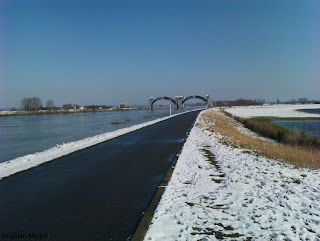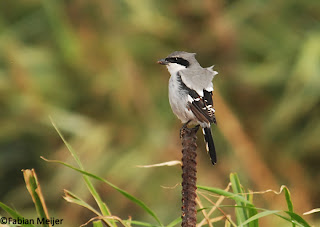On Saturday the 19th of October a group of birders discovered a Daurian Shrike near Vinkeveen, in the western part of the Netherlands. The previous years we've had good twitchable individuals (mostly on the isles) but this is still the 12th record orso for the Netherlands. I'd never seen one before so this was our target species number one.
We arrived at Waverhoek around 7.20 and it would still take half an hour to be able to scan de area for the shrike. During the sunrise we walked to the location, observing hundreds of geese and ducks departing from the lakes nearby. Also many Snipes. Arriving at the location we were the only ones present. As the light got better we started scanning. One hour later we still didn't have the shrike, and a group of ca.30 twitchers had gathered. We decided to go to IJmuiden since we could always do the bird on our way back home. As we walked back the same way we came we didn't find the shrike and got in the car. We drove away when I suddenly see a small group of people actively staring through their scopes and photographing something... a quick look from the car reveals the shrike! It had been present along a path where most of the twitchers had walked past during the morning when heading for the ''old location''!We had walked another path (so no blaming us for not finding it earlier haha).
The bird showed wonderfully, shifting between perching in a reedbed, some small bushes and undergrowth. Initially there were some doubts about the ID of the bird (either Red-tailed or Daurian). In the end the conclusion was Daurian Shrike.
Observations on the shrike: small shrike, lightbrown plumage, crown seemed a bit darker, with a more greybrown tinge, faint barring on the underparts, no barring uppertailcoverts, eye-stripe brownish, reddish orange tail. Amongst others light tips on greater coverts and pattern of tertails make it a 1st-winter. In active tail-moult. 3 old feathers with 7 new ones growing.
Daurian Shrike (digiscoped by Tammo)
Daurian Shrike (Lanius isabellinus), 1st winter
Next stop was the Zuidpier near IJmuiden. The last time I visited the place was already two years back. It was pleasant birding there. We soon located the Black Guillemot that has been present there for a while, great bird and great views!
Black Guillemot (Cepphus grylle), first winter
Other birds observed: 1st winter Shag, Rock Pipits, Red-throated Divers, Gannets, Pontic Gull, Yellow-legged Gull.
Red-throated Diver (Gavia stellata)
Gannet (Morus bassanus)
Purple Sandpiper (Calidris maritima)
It was a fantastic day, great company and wonderfull birds!





















































